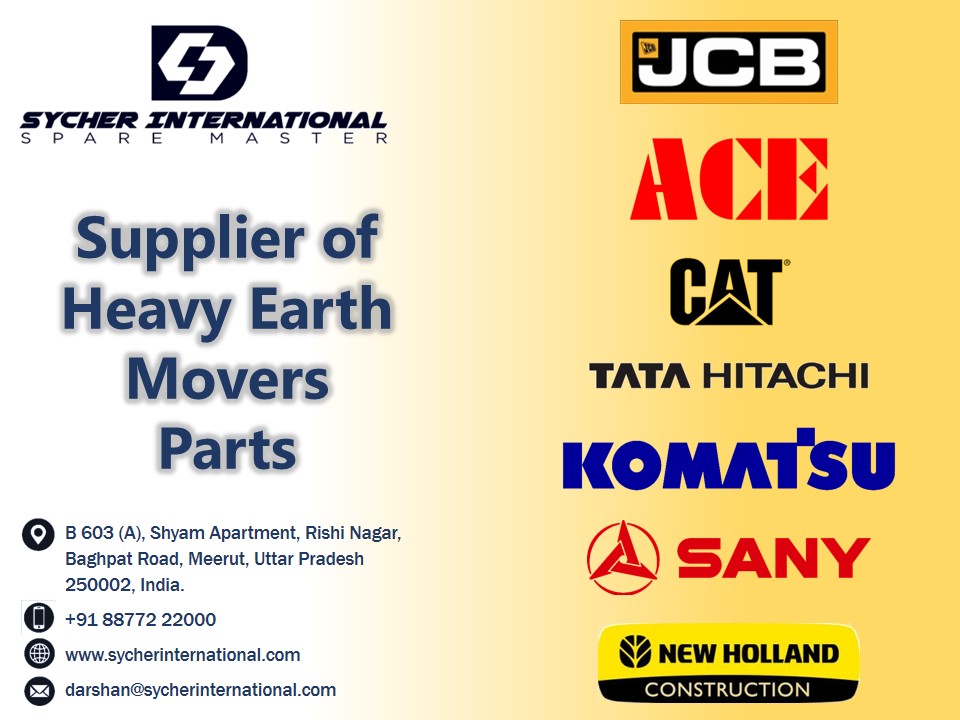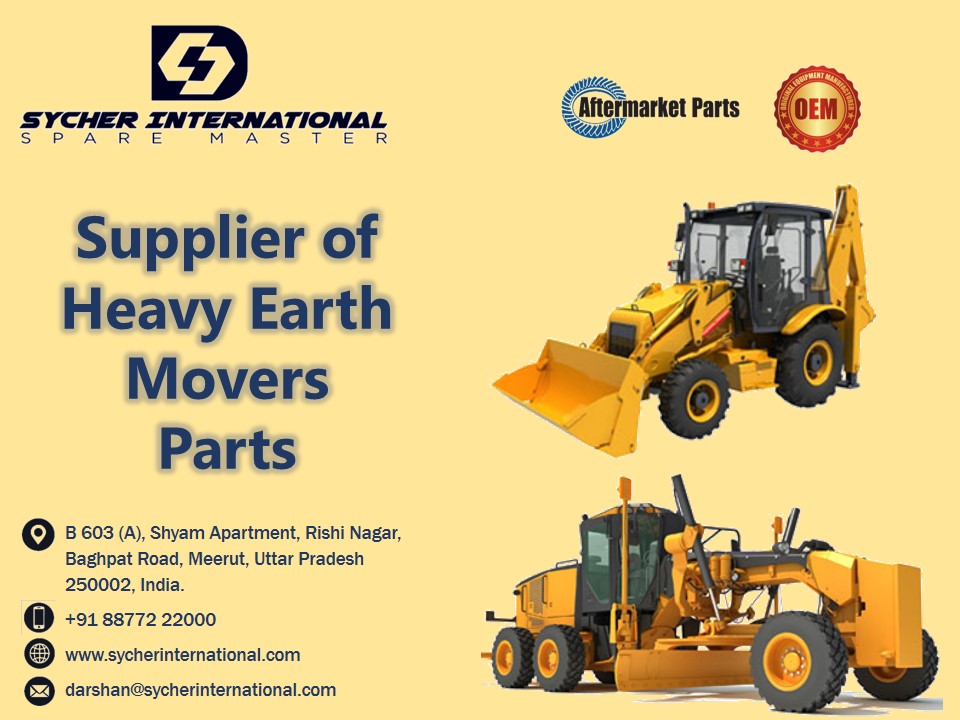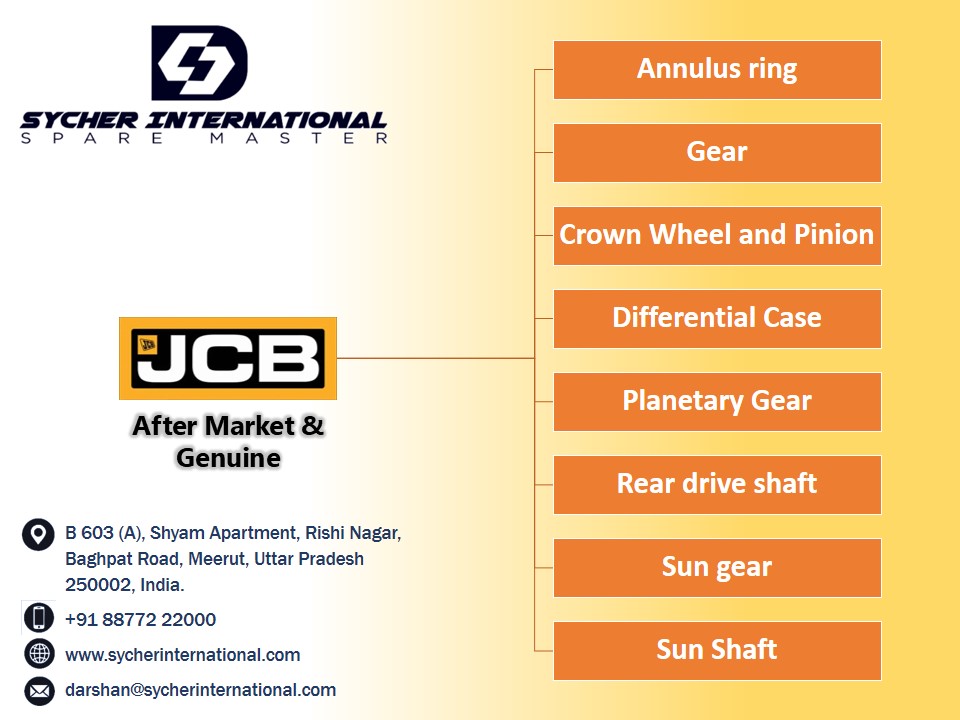What are heavy earthmovers?
Large vehicles made for diverse construction and earthmoving duties are known as heavy earth movers, heavy equipment, or construction machinery. These devices are designed primarily to undertake heavy-duty tasks and operate in difficult terrain. In construction, mining, and infrastructure projects, heavy earth movers are frequently employed to carry out duties like excavation, grading, hauling, and material handling. Bulldozers, excavators, loaders, dump trucks, and graders are a few examples of large earth movers.

what are the applications of large earth movers?
There are many different functions and applications for heavy earth movers across numerous sectors. Heavy earth movers are frequently used for the following purposes:
Excavation: For construction operations, as well as for mining and landscaping needs, heavy earth movers like excavators are used to excavate trenches, foundations, and holes.
Grading and leveling: To level the ground, make smooth surfaces, and guarantee adequate drainage on building sites and roadways, bulldozers and graders are used.
Hauling and material handling: Large quantities of materials, such as soil, rocks, gravel, sand, and building debris, are transported and moved within construction sites or from one area to another using dump trucks and loaders.
Heavy earthmovers with specialized attachments for demolition During demolition projects, tools like hydraulic breakers or demolition shears are utilized to take down structures and buildings.
Construction of new roads, highways, and bridges as well as the maintenance and repair of already-existing transportation infrastructure need the use of heavy equipment.
Mining and quarrying: Earth movers are essential for the removal of overburden, the excavation of pits, and the transportation of materials that have been extracted from mines and quarries.
Landscaping and land development: The reshaping and altering of land contours, the construction of ponds or lakes, the removal of vegetation, and the preparation of areas for landscaping or construction all include the use of heavy equipment.
Snow removal: In areas that receive a lot of snow, specialized heavy earthmovers are used to clean parking lots, roadways, and other surfaces. lots, as well as ice and snow in other places.
These are but a few instances; large earth movers can be used in a wide variety of other situations, depending on the demands of a certain project or sector.

Cost Effectiveness of heavy earth movers:
There are various economic considerations when owning and using huge earthmovers. Depending on the size and requirements of the equipment, the initial purchase costs might range from tens of thousands to millions of dollars. The cost of frequent service, repairs, and component replacements is included in maintenance charges and can add up over time. Given the powerful engines that drive this equipment, fuel consumption is another continuous expense. However, despite the costs, big earthmovers provide customers with significant returns on investment (ROI). These tools are used in mining and construction projects to increase production and efficiency. Greater project output produces income and maximizes ROI over time as a result of quicker turnaround times and improved workload capacity. Significant technological breakthroughs have been made recently in the heavy earthmoving equipment sector with the goals of increasing productivity, lowering operating costs, and reducing environmental effects. The development of autonomous capabilities is one noteworthy topic. For these devices to operate autonomously, manufacturers are integrating cutting-edge sensors, GPS systems, and artificial intelligence. Because it enables the equipment to function without human interference, lowering the danger of accidents and maximizing performance, this technology improves safety, productivity, and precision.
Improvements in fuel efficiency have also been a priority, pushed by both economic and environmental factors. To reduce fuel consumption and carbon emissions, engine manufacturers are implementing improved fuel injection systems, hybrid technologies, and energy recovery systems. Decreasing the environmental impact, not only decreases operational expenses but also encourages sustainability. of large machinery.
Strict laws have spurred the deployment of emission-reduction technologies to address pollution. Heavy earthmovers are increasingly being equipped with exhaust after-treatment devices like selective catalytic reduction and diesel particulate filters. By efficiently reducing dangerous emissions like nitrogen oxides and particulates, these solutions guarantee adherence to environmental regulations.
Telematics solutions are also becoming more popular in the sector. These technologies make it possible to remotely monitor the usage, performance, and maintenance requirements of the equipment. Real-time data analysis raises output and enables preventative upkeep, reducing downtime and increasing operational effectiveness. Telematics also gives operators information on fuel usage trends, allowing them to spot problem regions and decide how to cut operational expenses.
In general, these technological developments in large earthmoving machinery lead to safer operations. better cost-effectiveness for companies in the mining and construction industries, higher productivity, decreased fuel consumption, and lower pollutants.
Top brand name from where Indian exporters/suppliers purchased all heavy earth movers’ parts to import across the globe:
JCB, Caterpillar, Komatsu, Tata Hitachi, and Case IH are prominent brands in the heavy earthmover equipment industry. These companies supply a wide range of high-quality OEM parts for their respective equipment, ensuring reliable performance, durability, and compatibility for maintenance and repair needs in the construction and agricultural sectors.
The following paperwork is often required when importing heavy earthmovers:
Commercial Invoice: A thorough invoice given by the supplier or seller that includes the terms of the purchase as well as the description, amount, and value of the equipment.
Bill of Lading (B/L): A document that serves as a receipt for the items being carried, issued by the shipping firm or goods forwarder. It includes details on the shipment, including its origin, final destination, and consignee (buyer) information.
A list of the contents of each package or container being transported is known as a packing list. It contains details on the size, weight, and quantity of the imported equipment.
Import Permit: Certain types of machinery, such as large earthmovers, are subject to import license or permit requirements in some countries. Verify Whether an import permit is necessary should be confirmed with your country's customs officials.
A certificate of origin attesting to the heavy earthmovers' originality may be provided by the supplier or a recognized chamber of commerce. It offers proof of the location of the equipment's manufacturer.
Insurance Certificates or Policies: These cover the delivery and transportation of large earthmovers. This guarantees that the equipment is safeguarded from any potential loss or damage during shipment.
Customs Documentation: To provide details about the imported products and determine the necessary duties and taxes, several customs forms and declarations, such as a customs entry or import declaration, may be required.
Compliance Certificates: Depending on the location where you are traveling, you may be required to present compliance certificates or other documentation Specific safety, environmental, or technical requirements are met by the heavy earthmovers.
It's crucial to keep in mind that the precise documentation needs can change based on the importing country and any applicable laws. To ensure compliance with the relevant documentation requirements, it is advised to speak with customs brokers or goods forwarders who specialize in import/export operations.

Top importing countries importing heavy earth movers and heavy earth mover’s spare parts
The top importing nations for heavy earthmovers and their spare parts from India could change based on a number of variables, including market demand and commercial ties. However, some of the major importers of heavy earthmovers from India are as follows:
- The United States
- Emirate of the Arabs
- Australia Saudi Arabia
- S. Africa
- Indonesia
- Canada
- British Empire
- Malaysia
- Greece
- U.K
- Poland
- France
- Germany
- Czech
- Slovakia
- Slovenia